FOWL POX CAUSES & TRANSMISSION
- Dry Fowl Pox is a viral infection that affects a chicken’s skin in non-feathered areas, most commonly, the comb, wattles, face and eyelids.
- Wet Fowl Pox affects a bird’s upper respiratory system, eyes, mouth and throat and can be life-threatening.
- The virus is transmitted to backyard chickens by biting insects, most notably, mosquitoes.
- The virus is transmitted to other chickens within a flock through an infected bird’s feathers, feather debris, skin dander, sloughed-off scabs, scab secretions and blood (collectively referred to hereinafter as “hot debris“).
- Fowl Pox is highly contagious & spreads slowly from chicken to chicken within a flock. The virus can persist in a flock for months, sometimes years, in hot debris.
- Susceptible birds can become infected when hot debris is eaten, inhaled or makes contact with skin wounds or mucous membranes (eyeballs and mouths).
- Initial stages of Dry Fowl Pox include ash colored, raised lesions or blisters on the comb, face and wattles. Blisters evolve into larger, yellow bumps and finally, dark colored, wart-looking scabs. The scabs eventually resolve, leaving scars behind.
- Some chickens acquire immunity, but others are susceptible to recurrences in times of stress.
SYMPTOMS
Chickens with Fowl Pox will often exhibit a drop in egg production, loss of appetite and/or weight loss in addition to the tell-tale lesions on the skin (dry fowl pox) or lesions inside the mouth and throat (wet fowl pox). Symptoms generally persist for several weeks in a bird and several months in a flock.
PREVENTION
-Practice good biosecurity to avoid introducing fowl pox to your birds from an infected flock on your clothes, equipment or shoes.
–Quarantine new flock members properly.
–Control mosquitoes if possible.
-Day old chicks and unaffected adults can be vaccinated against Fowl Pox. The wing-stick method is easy to do and very affordable. Consult your flock’s veterinarian or state agriculture extension service poultry agent for more information about vaccinating against fowl pox. Your state’s contact information can be found HERE. Once chickens have been vaccinated, they have permanent immunity.
-During an outbreak, to limit the spread of the virus, clean and sanitize waterers daily, adding 1/4 teaspoon of Oxine per gallon of drinking water.
-Following an outbreak, clean and sanitize chicken coop with Oxine weekly for a month.
TREATMENT
There is no cure for fowl pox, but there are comfort measures that can be provided for affected chickens as well as preventative measures to avoid secondary bacterial infections caused by the lesions. Unaffected birds can be vaccinated during an outbreak.
1) Offer tetracycline antibiotics in the water to help control secondary infections. (see your vet for a prescription) In The Chicken Health Handbook, author Gail Damerow recommends 300mg of Terramycin per gallon of drinking water for 3 days followed by a vitamin supplement in the water, however, as of as of January 1, 2017, antimicrobials are only accessible by prescription from veterinarian under their care. Learn why HERE.
2) Treats scabs with a dilute iodine solution such as J. Crow’s Lugol’s Solution.
3) Apply ointment to soften scabs. (Mix 2 tablespoons of sulfur powder with 1/2 cup Vaseline. Apply to affected areas daily until lesion is healed.)
4) Mix diluted iodine solutions into the flock’s drinking water. (Iodine solution for drinking water: Mix 1 teaspoon of 1% iodine solution per gallon of water OR 1/2 teaspoon of 2% iodine solution per gallon. Provide as the only source of drinking water until outbreak subsides.)
5) Clean coop and run with the objective of removing hot debris from the premises.
6) Sanitize drinking water.
Many thanks to the following individuals for graciously sharing photos of their affected chickens with me for this article: Jennifer Sorensen, Jill Greenwell, Kim English and Nancy Campbell.
Kathy Shea Mormino
Affectionately known internationally as The Chicken Chick®, Kathy Shea Mormino shares a fun-loving, informative style to raising backyard chickens. …Read on


shop my SPONSORS
FOWL POX CAUSES & TRANSMISSION
- Dry Fowl Pox is a viral infection that affects a chicken’s skin in non-feathered areas, most commonly, the comb, wattles, face and eyelids.
- Wet Fowl Pox affects a bird’s upper respiratory system, eyes, mouth and throat and can be life-threatening.
- The virus is transmitted to backyard chickens by biting insects, most notably, mosquitoes.
- The virus is transmitted to other chickens within a flock through an infected bird’s feathers, feather debris, skin dander, sloughed-off scabs, scab secretions and blood (collectively referred to hereinafter as “hot debris“).
- Fowl Pox is highly contagious & spreads slowly from chicken to chicken within a flock. The virus can persist in a flock for months, sometimes years, in hot debris.
- Susceptible birds can become infected when hot debris is eaten, inhaled or makes contact with skin wounds or mucous membranes (eyeballs and mouths).
- Initial stages of Dry Fowl Pox include ash colored, raised lesions or blisters on the comb, face and wattles. Blisters evolve into larger, yellow bumps and finally, dark colored, wart-looking scabs. The scabs eventually resolve, leaving scars behind.
- Some chickens acquire immunity, but others are susceptible to recurrences in times of stress.
SYMPTOMS
Chickens with Fowl Pox will often exhibit a drop in egg production, loss of appetite and/or weight loss in addition to the tell-tale lesions on the skin (dry fowl pox) or lesions inside the mouth and throat (wet fowl pox). Symptoms generally persist for several weeks in a bird and several months in a flock.
PREVENTION
-Practice good biosecurity to avoid introducing fowl pox to your birds from an infected flock on your clothes, equipment or shoes.
–Quarantine new flock members properly.
–Control mosquitoes if possible.
-Day old chicks and unaffected adults can be vaccinated against Fowl Pox. The wing-stick method is easy to do and very affordable. Consult your flock’s veterinarian or state agriculture extension service poultry agent for more information about vaccinating against fowl pox. Your state’s contact information can be found HERE. Once chickens have been vaccinated, they have permanent immunity.
-During an outbreak, to limit the spread of the virus, clean and sanitize waterers daily, adding 1/4 teaspoon of Oxine per gallon of drinking water.
-Following an outbreak, clean and sanitize chicken coop with Oxine weekly for a month.
TREATMENT
There is no cure for fowl pox, but there are comfort measures that can be provided for affected chickens as well as preventative measures to avoid secondary bacterial infections caused by the lesions. Unaffected birds can be vaccinated during an outbreak.
1) Offer tetracycline antibiotics in the water to help control secondary infections. (see your vet for a prescription) In The Chicken Health Handbook, author Gail Damerow recommends 300mg of Terramycin per gallon of drinking water for 3 days followed by a vitamin supplement in the water, however, as of as of January 1, 2017, antimicrobials are only accessible by prescription from veterinarian under their care. Learn why HERE.
2) Treats scabs with a dilute iodine solution such as J. Crow’s Lugol’s Solution.
3) Apply ointment to soften scabs. (Mix 2 tablespoons of sulfur powder with 1/2 cup Vaseline. Apply to affected areas daily until lesion is healed.)
4) Mix diluted iodine solutions into the flock’s drinking water. (Iodine solution for drinking water: Mix 1 teaspoon of 1% iodine solution per gallon of water OR 1/2 teaspoon of 2% iodine solution per gallon. Provide as the only source of drinking water until outbreak subsides.)
5) Clean coop and run with the objective of removing hot debris from the premises.
6) Sanitize drinking water.
Many thanks to the following individuals for graciously sharing photos of their affected chickens with me for this article: Jennifer Sorensen, Jill Greenwell, Kim English and Nancy Campbell.



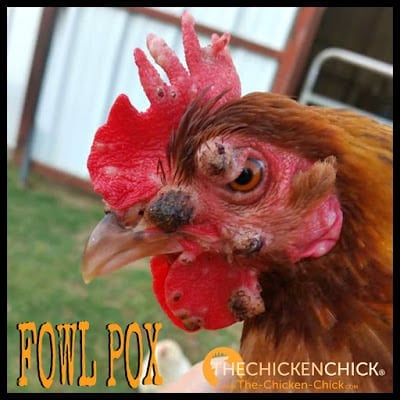

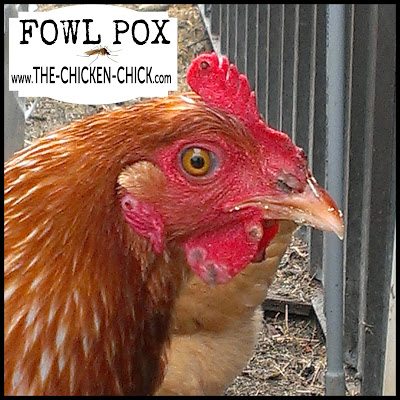
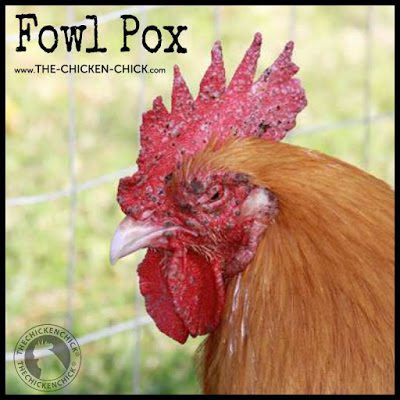
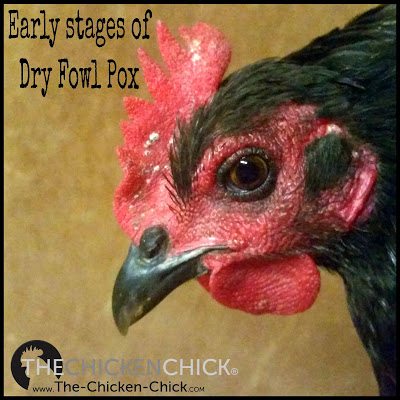
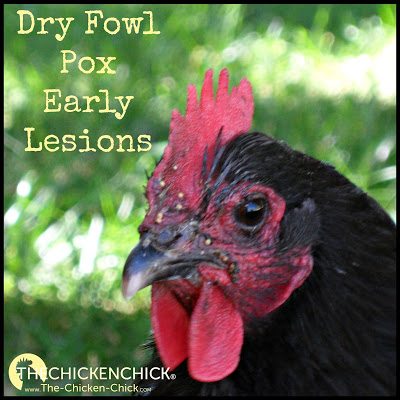

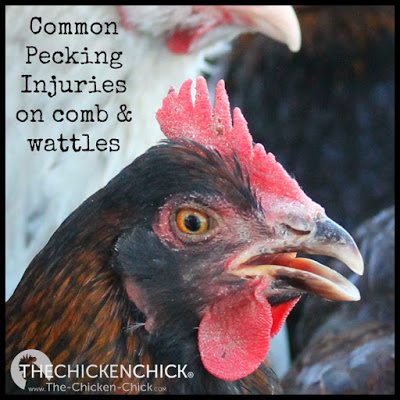
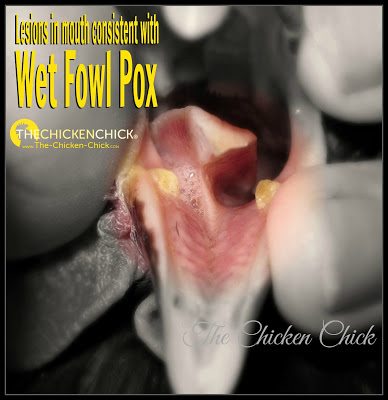

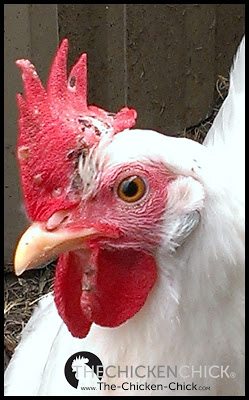















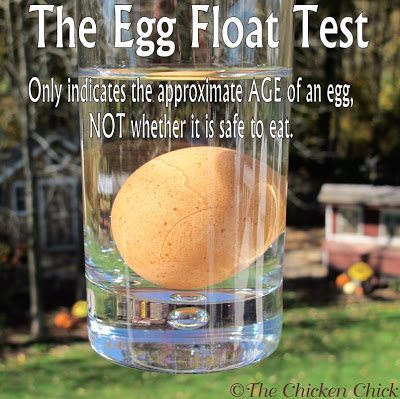










Thank you for the information, my chickens and turkeys 🦃🦃🦃 died because of fowl pox.
My hen came up with all these symptoms. I hit the internet for information and found your article to be most informative and helpful. I immediately separated her. Have 2 other hens with possible syntoms but I am getting ready for a full blown outbreak thanks to your article. Thank you for taking the time to present these articles.
Glad I could help. Best wishes to your flock!
Thank you, for all the info. It’s a Great help.
I just found a dry lesion on my leg horn. I have 20 birds so I have to check the whole peep now. Good info and thanks for posting
Many thanks, the info was helpful